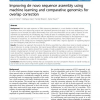7 search results - page 1 / 2 » HipMer: an extreme-scale de novo genome assembler |
BMCBI
2011
13 years 5 months ago
2011
Background: Next-generation sequencing technologies allow genomes to be sequenced more quickly and less expensively than ever before. However, as sequencing technology has improve...
BMCBI
2010
13 years 11 months ago
2010
Background: With the rapid expansion of DNA sequencing databases, it is now feasible to identify relevant information from prior sequencing projects and completed genomes and appl...
BIB
2007
13 years 11 months ago
2007
The contribution of transposable elements (TEs) to genome structure and evolution as well as their impact on genome sequencing, assembly, annotation and alignment has generated in...
BICOB
2009
Springer
14 years 5 months ago
2009
Springer
The de novo assembly of genomes from high-throughput short reads is an active area of research. Several promising methods have been recently developed, with applicability mainly re...
BMCBI
2010
13 years 11 months ago
2010
Background: Finishing is the process of improving the quality and utility of draft genome sequences generated by shotgun sequencing and computational assembly. Finishing can invol...

